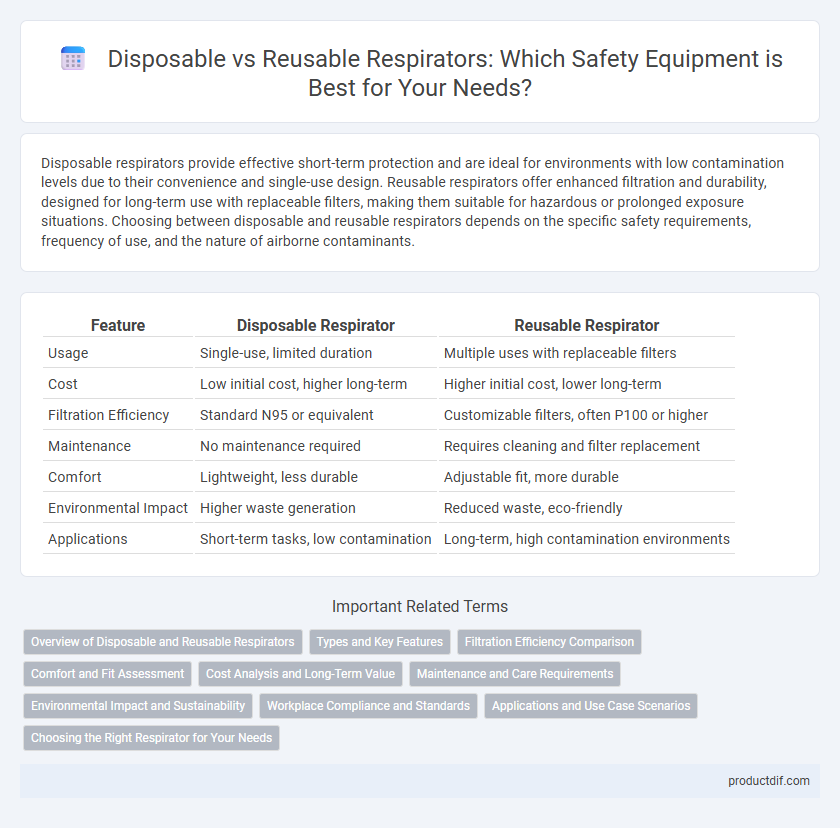Disposable respirators provide effective short-term protection and are ideal for environments with low contamination levels due to their convenience and single-use design. Reusable respirators offer enhanced filtration and durability, designed for long-term use with replaceable filters, making them suitable for hazardous or prolonged exposure situations. Choosing between disposable and reusable respirators depends on the specific safety requirements, frequency of use, and the nature of airborne contaminants.
Table of Comparison
| Feature | Disposable Respirator | Reusable Respirator |
|---|---|---|
| Usage | Single-use, limited duration | Multiple uses with replaceable filters |
| Cost | Low initial cost, higher long-term | Higher initial cost, lower long-term |
| Filtration Efficiency | Standard N95 or equivalent | Customizable filters, often P100 or higher |
| Maintenance | No maintenance required | Requires cleaning and filter replacement |
| Comfort | Lightweight, less durable | Adjustable fit, more durable |
| Environmental Impact | Higher waste generation | Reduced waste, eco-friendly |
| Applications | Short-term tasks, low contamination | Long-term, high contamination environments |
Overview of Disposable and Reusable Respirators
Disposable respirators provide single-use protection with lightweight materials designed to filter airborne particles effectively in short-term applications. Reusable respirators feature durable construction with replaceable cartridges or filters, offering enhanced protection and cost efficiency for long-term or frequent use. Both types comply with industry safety standards such as NIOSH certification, but selection depends on exposure duration, contaminant type, and user convenience.
Types and Key Features
Disposable respirators primarily include N95, P95, and N99 types designed for single-use filtration of airborne particles, featuring lightweight materials and ease of disposal for short-term tasks. Reusable respirators consist of half-face or full-face models with replaceable filters and cartridges, offering customizable protection against particulates, gases, and vapors for long-term industrial or hazardous environments. Key features of reusable respirators encompass adjustable straps, durable silicone or rubber face seals, and compatibility with various filter types to ensure enhanced comfort and extended usability.
Filtration Efficiency Comparison
Disposable respirators typically offer filtration efficiencies ranging from 95% to 99%, such as N95 or FFP2 models, effectively filtering out particulate matter and airborne contaminants. Reusable respirators, equipped with replaceable filters like P100 cartridges, can achieve filtration efficiencies up to 99.97%, providing superior protection against a wider range of hazardous particles and gases. The choice between disposable and reusable respirators depends on the required filtration level, exposure duration, and cost-effectiveness for specific industrial or healthcare environments.
Comfort and Fit Assessment
Disposable respirators generally offer a lightweight design with a snug fit ideal for short-term use, enhancing comfort during limited wear periods. Reusable respirators provide adjustable straps and customizable facepieces that accommodate varied facial structures, improving long-term comfort and secure fit for extended use. Proper fit assessment using fit-testing protocols ensures both types achieve optimal sealing to maximize respiratory protection and user comfort.
Cost Analysis and Long-Term Value
Disposable respirators generally have a lower upfront cost but incur higher expenses over time due to frequent replacements required after each use or work shift. Reusable respirators involve a higher initial investment for the mask and filters but offer greater long-term value by reducing waste and replacement costs, especially in environments with prolonged exposure to airborne contaminants. Evaluating factors such as filter lifespan, maintenance requirements, and workplace safety standards is essential for optimizing cost efficiency and ensuring effective respiratory protection.
Maintenance and Care Requirements
Disposable respirators require minimal maintenance as they are designed for single-use and must be discarded after contamination or specified usage duration; they eliminate cleaning and storage needs. Reusable respirators demand regular cleaning, filter replacement, and proper storage to ensure effective protection and durability, with maintenance protocols often specified by manufacturers. Failure to adhere to maintenance schedules on reusable respirators can compromise seal integrity and filtration efficiency, increasing exposure risks.
Environmental Impact and Sustainability
Disposable respirators contribute significantly to landfill waste due to their single-use nature and non-biodegradable materials, posing challenges for environmental sustainability. Reusable respirators offer a more sustainable option by reducing waste generation through replaceable filters and durable construction, enabling prolonged use while maintaining protection standards. Choosing reusable respirators aligns with eco-friendly safety practices by lowering carbon footprints and minimizing plastic pollution in occupational settings.
Workplace Compliance and Standards
Disposable respirators meet OSHA and NIOSH standards for single-use protection, ensuring compliance with workplace safety regulations and minimizing contamination risks. Reusable respirators require regular maintenance, filter replacement, and fit testing to comply with OSHA's respiratory protection standards, providing long-term cost efficiency and consistent protection. Both types must adhere to ANSI and OSHA guidelines, with selection based on hazard level, exposure duration, and company safety protocols.
Applications and Use Case Scenarios
Disposable respirators are ideal for short-term use in environments with low to moderate particulate exposure, such as construction sites, painting, and healthcare settings during pandemics. Reusable respirators suit prolonged, high-risk applications, including industrial manufacturing, chemical handling, and hazardous material response, where filters must be regularly replaced for sustained protection. Selecting between disposable and reusable respirators depends on factors like duration of use, contamination levels, and specific respiratory hazards encountered.
Choosing the Right Respirator for Your Needs
Choosing the right respirator depends on factors such as exposure duration, contaminant type, and frequency of use. Disposable respirators provide convenience and protection against particulate hazards for short-term or low-exposure tasks, while reusable respirators offer superior durability, customizable filters, and cost-efficiency for prolonged or high-risk environments. Evaluating workplace safety requirements and compliance with OSHA standards ensures optimal respiratory protection and user safety.
Disposable respirator vs Reusable respirator Infographic

 productdif.com
productdif.com